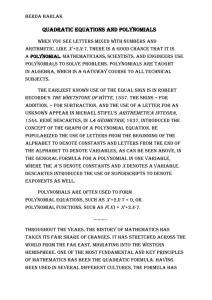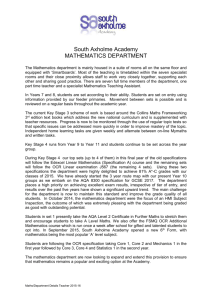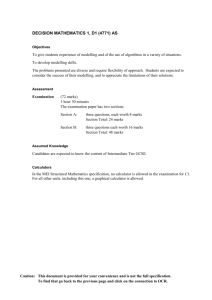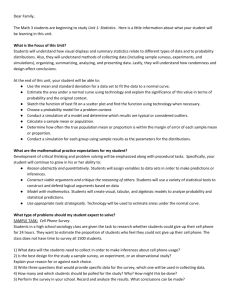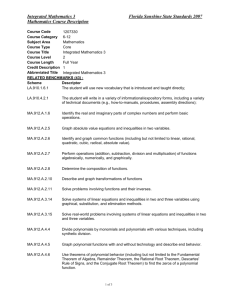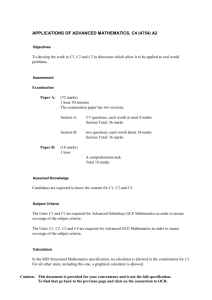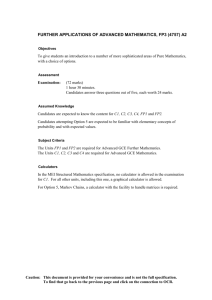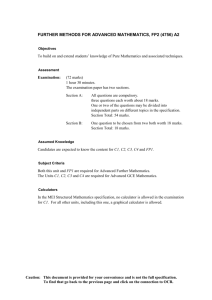INTRODUCTION TO ADVANCED MATHEMATICS, C1 (4751) AS
advertisement
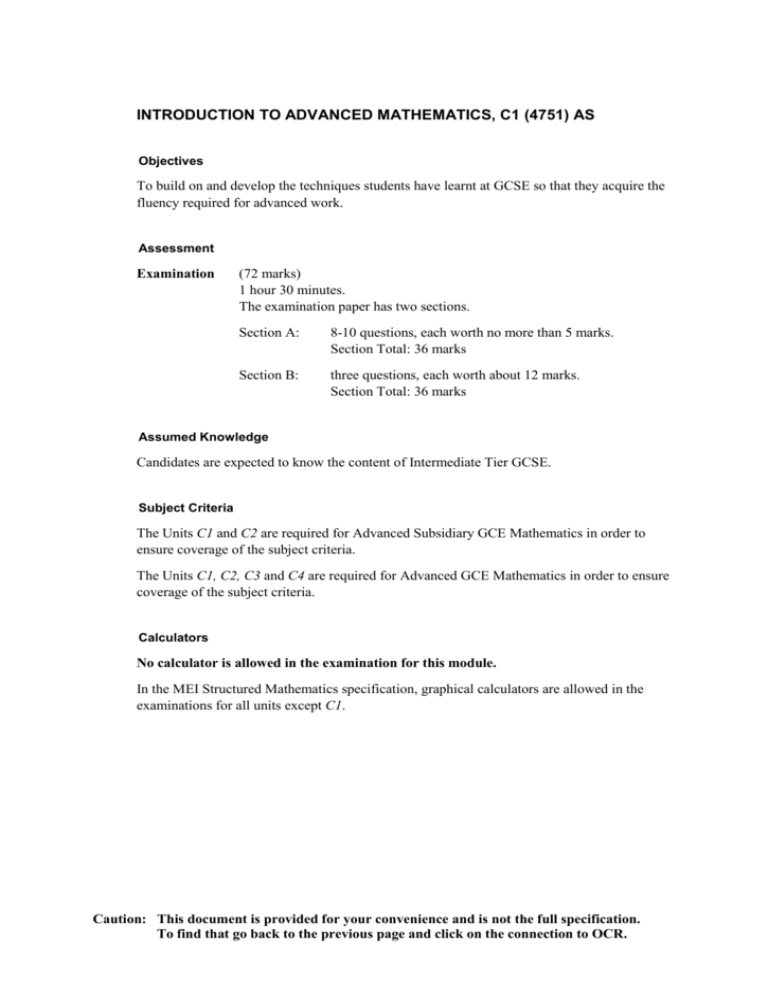
INTRODUCTION TO ADVANCED MATHEMATICS, C1 (4751) AS Objectives To build on and develop the techniques students have learnt at GCSE so that they acquire the fluency required for advanced work. Assessment Examination (72 marks) 1 hour 30 minutes. The examination paper has two sections. Section A: 8-10 questions, each worth no more than 5 marks. Section Total: 36 marks Section B: three questions, each worth about 12 marks. Section Total: 36 marks Assumed Knowledge Candidates are expected to know the content of Intermediate Tier GCSE. Subject Criteria The Units C1 and C2 are required for Advanced Subsidiary GCE Mathematics in order to ensure coverage of the subject criteria. The Units C1, C2, C3 and C4 are required for Advanced GCE Mathematics in order to ensure coverage of the subject criteria. Calculators No calculator is allowed in the examination for this module. In the MEI Structured Mathematics specification, graphical calculators are allowed in the examinations for all units except C1. Caution: This document is provided for your convenience and is not the full specification. To find that go back to the previous page and click on the connection to OCR. INTRODUCTION TO ADVANCED MATHEMATICS, C1 Specification Ref. Competence Statements Competence statements marked with an asterisk * are assumed knowledge and will not form the basis of any examination questions. These statements are included for clarity and completeness. MATHEMATICAL PROCESSES Proof The construction and presentation of mathematical arguments through appropriate use of logical deduction and precise statements involving correct use of symbols and appropriate connecting language pervade the whole of mathematics at this level. These skills, and the Competence Statements below, are requirements of all the modules in these specifications. Mathematical argument C1p1 2 Understand and be able to use mathematical language, grammar and notation with precision. Be able to construct and present a mathematical argument. Modelling Modelling pervades much of mathematics at this level and a basic understanding of the processes involved will be assumed in all modules The Modelling Cycle The modelling cycle. C1p3 Be able to recognise the essential elements in a modelling cycle. Caution: This document is provided for your convenience and is not the full specification. To find that go back to the previous page and click on the connection to OCR. INTRODUCTION TO ADVANCED MATHEMATICS, C1 Specification Ref. Competence Statements ALGEBRA The basic language of algebra. Solution of equations. Inequalities. Surds. Indices. C1a1 Know and be able to use vocabulary and notation appropriate to the subject at this level. 2 * Be able to solve linear equations in one unknown. 3 Be able to change the subject of a formula. 4 Know how to solve an equation graphically. 5 Be able to solve quadratic equations. 6 Be able to find the discriminant of a quadratic function and understand its significance. 7 Know how to use the method of completing the square to find the line of symmetry and turning point of the graph of a quadratic function. 8 * Be able to solve linear simultaneous equations in two unknowns. 9 Be able to solve simultaneous equations in two unknowns where one equation is linear and one is of 2nd order. 10 Know the significance of points of intersection of two graphs with relation to the solution of simultaneous equations. 11 Be able to solve linear inequalities. 12 Be able to solve quadratic inequalities. 13 Be able to use and manipulate surds. 14 Be able to rationalise the denominator of a surd. 15 Understand and be able to use the laws of indices for all rational exponents. 16 Understand the meaning of negative, fractional and zero indices. Caution: This document is provided for your convenience and is not the full specification. To find that go back to the previous page and click on the connection to OCR. INTRODUCTION TO ADVANCED MATHEMATICS, C1 Specification The co-ordinate geometry of straight lines. The co-ordinate geometry of curves. Ref. Competence Statements C1g1 CO-ORDINATE GEOMETRY *Know the equation y mx c . 2 Know how to specify a point in Cartesian co-ordinates in two dimensions. 3 Know the relationship between the gradients of parallel lines and perpendicular lines. 4 * Be able to calculate the distance between two points. 5 * Be able to find the co-ordinates of the midpoint of a line segment joining two points. 6 Be able to form the equation of a straight line. 7 Be able to draw a line when given its equation. 8 Be able to find the point of intersection of two lines. 9 * Know how to plot a curve given its equation. 10 Know how to find the point of intersection of a line and a curve. 11 Know how the find the point(s) of intersection of two curves. 12 Understand that the equation of a circle, centre (0, 0), radius r is x 2 y 2 r 2 13 Understand that ( x a)2 ( y b)2 r 2 is the equation of a circle with centre (a, b) and radius r . 14 Know that: – the angle in a semicircle is a right angle; – the perpendicular from the centre of a circle to a chord bisects the chord; – the tangent to a circle at a point is perpendicular to the radius through that point. Caution: This document is provided for your convenience and is not the full specification. To find that go back to the previous page and click on the connection to OCR. INTRODUCTION TO ADVANCED MATHEMATICS, C1 Specification Ref. Competence Statements POLYNOMIALS Basic operations on polynomials. C1f1 Know how to add, subtract, multiply and divide polynomials. The factor theorem. 2 Understand the factor theorem and know how to use it to factorise a polynomial. 3 Know how to use the factor theorem to solve a polynomial equation. 4 Know how to use the factor theorem to find an unknown coefficient. The remainder theorem. 5 Understand the remainder theorem and know how to use it. Graphs. 6 Know how to sketch the graphs of polynomial functions. Binomial expansions. 7 Know how to use Pascal's triangle in the binomial expansion of (a x)n where n is a positive integer. 8 n Know the notations nCr and r , and their relationship to Pascal's triangle. 9 Know how to use nCr in the binomial expansion of (a b)n where n is a positive integer. CURVE SKETCHING Vocabulary. C1C1 Understand the difference between sketching and plotting a curve. Quadratic curves. 2 Know how to sketch a quadratic curve with its equation in completed square form. Polynomial curves. 3 Know how to sketch the curve of a polynomial in factorised form. Transformations. 4 Know how to sketch curves of the forms y f ( x) a and y f ( x b) , given the curve of y f ( x) . Caution: This document is provided for your convenience and is not the full specification. To find that go back to the previous page and click on the connection to OCR.

